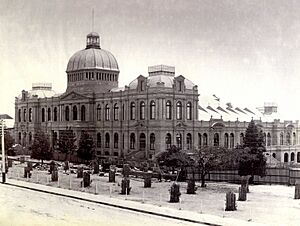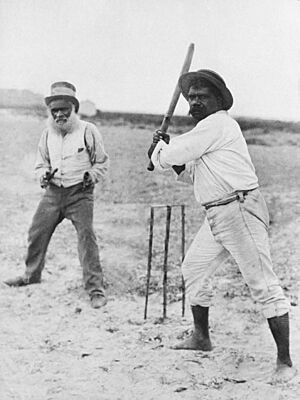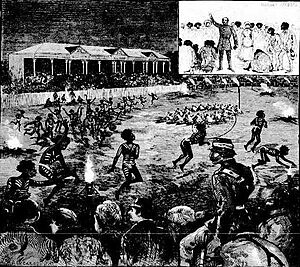Harry Hewitt facts for kids
Harry Hewitt, sometimes known as "Hewit", was an amazing Indigenous Australian athlete. He played both cricket and Australian rules football. In 1889, Harry played for the Medindie Football Club. This makes him the first Indigenous Australian to play in the South Australian Football Association (SAFA), which is now called the South Australian National Football League (SANFL).
Quick facts for kids Harry Hewitt |
|||
|---|---|---|---|
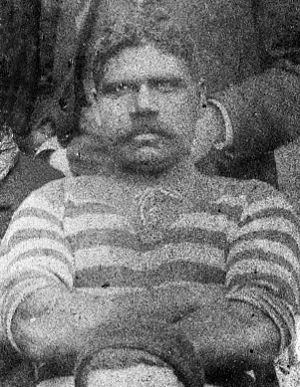
Hewitt in 1894
|
|||
| Personal information | |||
| Full name | Harry Hewitt | ||
| Date of birth | c. 1862 | ||
| Place of birth | South-eastern South Australia | ||
| Date of death | 23 January 1907 (approx. 45) | ||
| Original team | Point McLeay | ||
| Position(s) | Back pocket, rover | ||
| Career highlights | |||
|
|||
Contents
Early Life and Talents
Harry Hewitt was born in south-east South Australia. He was a member of the Bungandidj people. As a child, he moved to the Point McLeay Mission station. This mission is now known by its original Indigenous name, Raukkan. The famous inventor and writer David Unaipon was also born at Point McLeay Mission around this time.
Harry was known for being a "champion climber". Once, he climbed a very tall gum tree near the Hindmarsh River. He carved his initials into the top of the tree with a tomahawk.
Football Career
In the 1880s, Harry and other Indigenous Australians from Point McLeay often traveled to Adelaide. They played Australian rules football games against city teams. When they stayed in Adelaide, the Point McLeay players sometimes slept under trees at Unley Park.
Early Games and Captaincy
In 1884, Harry played in several games against the Strathalbyn Football Club. He was often named among Point McLeay's best players.
In 1885, a special football match was held at Adelaide Oval. Harry Hewitt captained an All-Indigenous team called 'Aboriginals'. They played against a combined team called 'Wanderers'. Many people thought the Wanderers would win easily. However, the game was very close and ended in a draw. Harry's team played the whole match without shoes.
After this success, another game was played a few days later. Harry's Point McLeay team won this second match by one goal. Later that year, the Point McLeay team returned to Adelaide. They played against a senior SAFA club, Old Adelaide, and impressively managed a draw.

Playing in the SAFA
On June 22, 1889, Harry Hewitt made his senior debut for Medindie in the South Australian Football Association (SAFA). He played against Port Adelaide at Adelaide Oval. A local newspaper praised his play, saying he was "a decided acquisition" and "about the best man amongst them". They noted his speed and good understanding of the game rules.
In June 1891, Harry played a great game for Medindie against Adelaide. A newspaper wrote that he "ought to prove of great benefit to the Medindies". Another paper called him the best player on the field.
On August 1, 1891, Harry played for Port Adelaide against a visiting team from Fitzroy. Port Adelaide won this game.
Later Football and Legacy
In 1892, Harry was chosen to play for a team representing Southern South Australia. This team played against a Northern team. Harry's Southern side won the match. Newspapers praised Harry and his teammate Wilson for their "clever football" and "agility".
Harry Hewitt is remembered as the first Indigenous Australian to play in the SANFL. In 2020, the Port Adelaide Football Club honored him. They included his name on their special guernsey for the Sir Doug Nicholls Indigenous Round.
Cricket Achievements
Harry Hewitt was also a talented cricketer. In 1882, he helped a combined Milang and Point McLeay team beat the North Adelaide Cricket Club. A report said he "particularly distinguished himself".
In 1885, Harry's Point McLeay team played against the Milang Cricket Club. Harry took 6 wickets, helping his team win.
In 1892, Harry had an amazing batting average of 130 for Point McLeay. He scored 126 runs in one game and 107 runs (not out) in another. A writer encouraged him, saying, "Go on, Harry, my boy, keep at it, and may you get into an intercolonial before long."
In 1893, Harry played in the 'North v. South' cricket match at Adelaide Oval. He scored 42 runs in the first innings. In 1894, an Indigenous cricket team with Harry beat a white team in Goolwa. Harry was the top scorer with 51 runs.
In 1895, playing for a Northern Adelaide team, Harry scored 144 runs, not out. In 1897, he was described as "The best batsman we met". He was praised for his batting, bowling, and fielding.
In 1898, Harry captained the Point McLeay cricket team. During a break in the game, his team showed off their boomerang throwing skills. In his last season for Victor Harbor, Harry averaged 70 runs.
Cricket Style
Harry was known for his "very fine late cut stroke" in batting. He had an "unusual stance" but could hit the ball with great power. He was also a "wonderful" fielder and very fast when running between the wickets.
One person described him: "Harry Hewitt in the realm of sport had few equals. At cricket he was quite an entertainment... It was like bowling at a well-charred stump. Harry with his pants rolled knee high, no boots, standing right in line with the wicket... was a most formidable object to bowl at."
Community Leader
Speaking Up for Rights
Harry Hewitt also spoke up for Indigenous people. He tried to make a living as a fisherman. In the 1880s, he wrote a letter to a newspaper about fishing licenses. He explained that white people had taken their land and game. Now, Indigenous people were expected to pay for a license to fish for food. He felt this was unfair, as it made it harder for them to earn money.
Cultural Demonstrations
In May 1885, Harry helped organize two corroboree performances at Adelaide Oval. These events were held after a football match he played in. About 20,000 people watched the corroboree on one night. This was a huge crowd for the time. The money raised was meant to help the Indigenous people of Point McLeay.
In 1905, Harry personally organized another corroboree in Victor Harbor. He gathered 20 other Indigenous Australians for the event. Almost the whole town came to watch. This event was special because Harry organized it himself in a popular tourist area.
Harry also taught Sir Edward Lucas how to throw a boomerang. Later, when Lucas was in London, he would show off his boomerang skills and give credit to Harry.
Personal Life
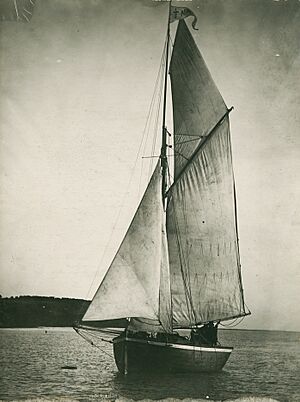
Harry Hewitt was a Bungandidj man.
He married Mary Unaipon in 1884. Mary was the daughter of James Unaipon and the sister of David. Harry and Mary had a daughter named Ruth, who became a pianist. Mary passed away in 1891.
Harry later married Agnes. They had a son named Oliver. Oliver served as a private for Australia in World War 1.
Harry was very good at English. He could read and write well and knew a lot about different topics. People said he was a keen reader of newspapers. They believed that if he had received more education as a child, he would have been a great businessman.
He also enjoyed dancing and was described as being "remarkably light on his feet". He was also a skilled acrobat and gymnast. For some time, he even worked with a traveling circus.
By 1907, Harry was working as a boatman for the Point McLeay Mission. He was in charge of a boat called the "Teen Minnie". Harry was also a noted swimmer.
Images for kids
-
Murray River paddle steamer 'Bourke' transported the Milang Cricket Club players to Point McLeay in 1885




